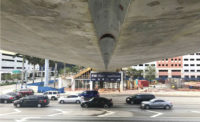On the afternoon of Sept. 26, 2013, a naval cargo ship struck the Mathews Bridge, one of Jacksonville's principal arterial expressways, severing the bridge's north bottom truss chord. Within an hour, the Florida Dept. of Transportation (FDOT) had officially declared the situation an emergency, enabling the agency to launch emergency repair efforts.
More than 56,000 Jacksonville-area commuters who use the bridge daily were counting on FDOT and its emergency response team to quickly determine a repair strategy for which there was no known precedent. The plan was to pull the ends of the severed chord back into position to relieve stresses across the structure and hold them in place while permanent repairs to the damaged members were made.
Just 34 days after the crash occurred, the Mathews Bridge—Florida's first and oldest high-level truss bridge—was back in service thanks to a fast-track, 24/7 design and construction effort involving a multidisciplinary team of more than 200 professionals.
Despite the unique nature of the repair challenge, a complete bid package with scope of work, sequence of construction and repair plans was ready for bidders within 76 hours of the incident. Advanced 3D laser scanning technology produced detailed images for shop drawing development, while the team used smartphone and tablet applications to transmit specifications directly to the steel supplier, facilitating an around-the-clock fabrication effort.
During the first week, bridge inspectors surveyed positions along the deck to watch for signs of continual creep. Other time-sensitive innovations applied during the repair process included heat-straightening damaged gusset plates, replacing all existing rivets with custom fabricated bolts and utilizing an overlapping gusset plate to restore the full capacity of the joint without having to remove any existing members.
A stub-beam was used as part the west connection of the new lower chord section to the existing gussets, eliminating fit-up issues associated with attempting to splice a 33-ft-long new chord between two panel points. Installing the more easily maneuverable stub-beam first allowed the remainder of the new chord to be field-cut to the necessary length to finalize the chord replacement.
In addition, the project team devised the use of a system of rollers to move heavy repair beams onto the damaged section without adding the weight of a crane. By project's end, the contracting team had replaced nearly 20,000 lb of permanent steel and installed more than 1,000 bolts.
Complementing the expedited nature of the repairs was the project team's heightened safety consciousness, given the structure's instability and uncertain response to the repair work.
In addition to mandating personal fall protection measures for all onsite personnel, an innovative strongback system with saddles alleviated vertical loads from the truss and construction activities. Daily surveys, strain gauges and periodic load tests helped the team monitor and verify that the structure was stable and that forces were properly distributed until the final repairs were completed.
Best Emergency Repairs - Mathews Bridge Emergency Repairs
Key Players
Contractor Superior Construction Co., Jacksonville, Fla.
Owner Florida Dept. of Transportation, Lake City, Fla.
Lead Designer RS&H, Jacksonville
Consultant HNTB, Jacksonville















Post a comment to this article
Report Abusive Comment